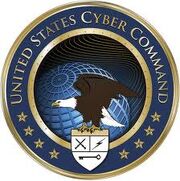
Overview[]
In June 2009, the Secretary of Defense issued a memorandum[1] directing the creation of U.S. Cyber Command (USCYBERCOM) as a subunified command to U.S. Strategic Command (USSTRATCOM), and requiring the military departments to identify and provide appropriate component support to U.S. Cyber Command, and to have this support in place and functioning prior to the new subunified command’s reaching full operating capability.
The memo required U.S. Cyber Command to focus on integration of cyberspace operations and possess the technical capability to address the risk of cyber threats and vulnerabilities and secure freedom of action in cyberspace. The memo further called for U.S. Cyber Command to “synchroniz[e] warfighting effects across the global security environment,” as well as support civil authorities and international partners.
U.S. Cyber Command was declared to be at full operating capability on October 31, 2010. It superseded the following component commands:
- Joint Functional Component Command for Network Warfare (JFCC NW), which was responsible for planning, integrating, and coordinating cyberspace capabilities and integrating with all necessary computer network operations capabilities.
- Joint Task Force-Global Network Operations, which was responsible for DOD’s global network operations and directing the operation and defense of DOD’s global information grid.
- Joint Information Operations Warfare Center, which was the lead entity responsible for planning, integrating, synchronizing, and advocating for information operations across DOD including computer network operations, electronic warfare, psychological operations, military deception, and operations security.
The establishment of USCYBERCOM reflects DoD’s need to:
- Manage cyberspace risk through efforts such as increased training, information assurance, greater situational awareness, and creating secure and resilient network environments;
- Assure integrity and availability by engaging in smart partnerships, building collective self-defenses, and maintaining a common operating picture; and
- Ensure the development of integrated capabilities by working closely with Combatant Commands, Services, Agencies, and the acquisition community to rapidly deliver and deploy innovative capabilities where they are needed the most.
USSTRATCOM has delegated to USCYBERCOM the responsibility for synchronizing and coordinating Service components within each branch of the military, including U.S. Army Cyber Command/2nd Army, U.S. Fleet Cyber Command/U.S. 10th Fleet, the 24th Air Force, U.S. Marine Corps Forces Cyber Command, and U.S. Coast Guard Cyber Command.
USCYBERCOM has identified three lines of operation: DOD Global Information Grid operations, defensive cyberspace operations, and offensive cyberspace operations.
The USCYBERCOM also maintains a website that focuses on cybersecurity.
A key organizational concept behind the stand-up of USCYBERCOM is its co-location with the National Security Agency (NSA). The Director of the National Security Agency is also designated as Commander of U.S. Cyber Command. It is supported by the Defense Information Systems Agency (DISA) which, among other things, is responsible for designing, provisioning, operating, and maintaining certain DOD classified and unclassified networks. Additionally, U.S. Cyber Command receives infrastructure, security, information assurance, and various other forms of support from the National Security Agency.
Concept of Operations[]
U.S. Cyber Command has developed a "Concept of Operations." The document, signed by the Commander of U.S. Cyber Command in September 2010 and released in November 2010, lays out broad roles and responsibilities for cyberspace operations. The Concept of Operations states in its commander’s intent section that the Commander of U.S. Cyber Command’s top priorities include the following: improving the security and defense of U.S. military networks, maturing U.S. Cyber Command, working with the services to build the cyber force, and collaborating with partners. Additionally, the Concept of Operations states that U.S. Cyber Command will exercise control of assigned and attached forces to operate and defend DOD networks as well as conduct offensive cyberspace operations, as directed. It further states that the services retain primary responsibility to man, train, and equip for mission readiness, administration, and management of those forces under the command and control of U.S. Cyber Command.
The Concept of Operations directs the service components assigned to U.S. Cyber Command to develop capabilities in support of operational requirements from U.S. Cyber Command, and also to provide shared situational awareness of their portions of DOD networks. Further, the Concept of Operations identifies and delegates areas of authority and responsibility throughout the U.S. Cyber Command organizational structure. Accompanying annexes are expected to provide greater detail about the command’s plans to conduct cyberspace operations.
Commander, U.S. Cyber Command[]
"The Commander, U.S. Cyber Command (USCYBERCOM) is responsible for executing the cyberspace missions specified in Section 18.d.(3)of the Unified Command Plan (UCP) as delegated by the Commander, U.S. Strategic Command (USSTRATCOM) to secure our nation's freedom of action in cyberspace and to help mitigate risks to our national security resulting from America's growing dependence on cyberspace.
Subject to such delegation and in coordination with mission partners, specific missions include: directing DODIN operations, securing and defending the DODIN; maintaining freedom of maneuver in cyberspace; executing full-spectrum military cyberspace operations; providing shared situational awareness of cyberspace operations, including indications and warning; integrating and synchronizing of cyberspace operations with combatant commands and other appropriate U.S. Government agencies tasked with defending the our nation's interests in cyberspace; provide support to civil authorities and international partners. All these efforts support DoD's overall missions in cyberspace of defending the nation against cyber attacks, supporting the combatant commands, and defending Department of Defense networks."[2]
References[]
- ↑ Chief of Naval Operations, Fleet Cyber Command/Commander Tenth Fleet Implementation Plan, Memorandum, United States Navy (2009).
- ↑ Advanced Questions for Vice Admiral Michael S. Rogers, Nominee for Commander, United States Cyber Command, Senate Armed Services Hearing of March 11, 2014 (Rogers_03-11-14.pdf full-text).
See also[]
Sources[]
- Department of Defense Strategy for Operating in Cyberspace, at 5-6.
- Defense Department Cyber Efforts: More Detailed Guidance Needed to Ensure Military Services Develop Appropriate Cyberspace Capabilities, at 3-4.